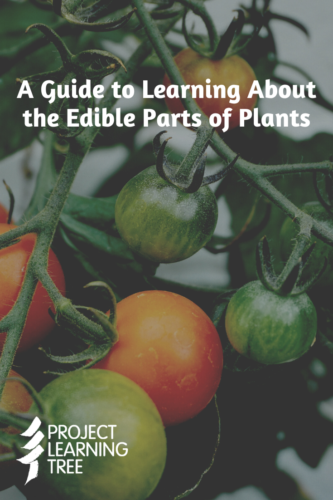 We eat different plant parts every day, from fruits and vegetables to hearty grains to sunflower seeds as snacks. When using plants as teaching tools, it’s important that we give students of all ages some necessary context.
We eat different plant parts every day, from fruits and vegetables to hearty grains to sunflower seeds as snacks. When using plants as teaching tools, it’s important that we give students of all ages some necessary context.
Different parts of plants can have different uses, including as a nutrition source. When it comes to how Indigenous Peoples have interacted with many of these plants, there’s an added layer of both historical and cultural significance. Let’s learn more about different edible plant parts, including less well-known native plants that may be a more sustainable option for us.
Leaves
Leaves produce food for plants through photosynthesis, a process that allows plants to capture energy from the sun. Students may already recognize edible leaves in their daily diets. Nopales, lettuce, spinach, Swiss chard, collard greens, basil, oregano, bok choy, choy sum, and mustard greens are all examples of edible leaves.
Edible leaves used by Indigenous communities throughout the United States include:
- Lamb’s Quarters: This leafy weed is also known as white goosefoot. It’s found in every state in the U.S. except Hawaii, and you’re most likely to see it growing wild. The greens can be used like spinach. Mix it with salads, steam it as a side, or add it to soup. The seeds have also traditionally been ground into a starchy meal. Learn more here.
- Western Dock: This flowering plant is most common in western states like California, Nevada, and Idaho. Traditionally, the leaves have been used as a paste to treat injuries and as a dye. For culinary purposes, cook the leaves like spinach for a tart flavor profile in stews, stir fry dishes, and soups. Learn more here.
- Redwood Sorrel: This perennial herb grows well in the cool, damp forests of the Northwest. Redwood sorrel is edible raw in limited amounts because of the presence of oxalic acid. You can also cook it in dishes that call for acidity or brew the leaves for tea. Learn more here.
Buds and Flowers
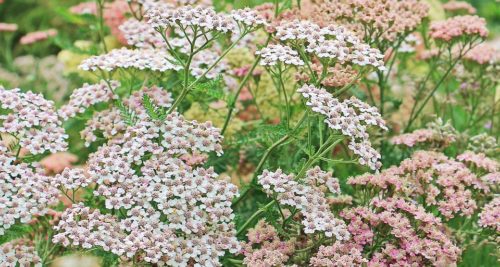 Buds are the start of a flower or leaf. The flowers themselves are the plant part responsible for seeds and further reproduction of that plant. Cauliflower, broccoli, cabbage, artichoke, and hibiscus are buds and flowers students may have seen before.
Buds are the start of a flower or leaf. The flowers themselves are the plant part responsible for seeds and further reproduction of that plant. Cauliflower, broccoli, cabbage, artichoke, and hibiscus are buds and flowers students may have seen before.
Buds and flowers include:
- Squash Blossoms: A summertime treat at farmers’ markets nationwide. How they’re used in kitchens depends on cultural traditions. They’re stuffed with cheese and fried in Italy. In Latin America, you’ll find them raw in salads or cooked with veggies. Learn more here.
- Anise Hyssop: This plant in the mint family is native to the prairies and fields in the Midwest and Great Plains. Indigenous Peoples have used it for medical purposes. Its antioxidant properties are well documented, but it’s also suitable for everyday use in teas, as a flavoring for jelly, or as an herbal boost in salads. Learn more here.
- Yarrow: Clusters of yarrow flowers can be found throughout the United States during spring blooming seasons. Indigenous Peoples have traditionally used yarrow as a cure for aches and pains. Yarrow can also be used as a dried spice or as an alternative to tarragon in dressings, salads, and soups. Learn more here.
Want to learn more about flowers and buds? Try the Bursting Buds activity from the Explore Your Environment: K-8 Activity Guide with your students.
Fruits and Drupes
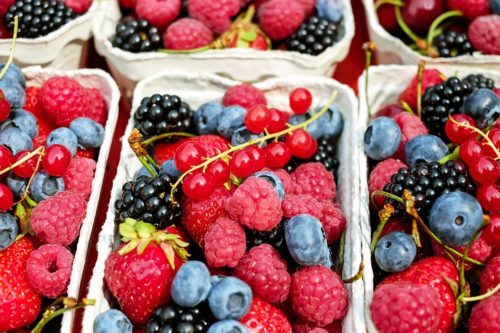 A drupe is a type of fruit that has one single seed. All types of fruit, including drupes, berries, and pomes, are the products of a plant’s growth. These are likely the most popular edible plant parts among your students.
A drupe is a type of fruit that has one single seed. All types of fruit, including drupes, berries, and pomes, are the products of a plant’s growth. These are likely the most popular edible plant parts among your students.
It may be fun to have students list as many as they can before getting into the differences in fruits. Apples, pears, and watermelon are likely some of the first to be called out, but have them think a little harder for examples of pitted drupes. Cherries, mangos, peaches, olives, walnuts, and almonds are all drupes.
Examples of fruits and drupes:
- Acorns: Acorns are found wherever oak trees grow, as they’re the fruit of those trees. You can mash acorns into a flour for use in breads, soups, and patties. Shell ripe acorns and then soak them in warm or cold water to remove the tannins. Learn more here.
- Pawpaw: The pawpaw is the largest fruit native to the U.S. You can find it all over the country as a crop or growing wild in areas with floodplains. Indigenous Peoples would mash the fruit for dried cakes or ate them raw as they ripened. You can also use the fruit in baked goods, frozen, or mashed as puddings. Learn more here.
- Chokecherry: The chokeberry is the state fruit (or technically, the state drupe), of North Dakota. It’s an important component of some Indigenous community ceremonies and has been used as a medicinal source. The tart cherries are best in jellies, syrups, and preserves, which means you can also use them in your baked goods. Learn more here.
Seeds
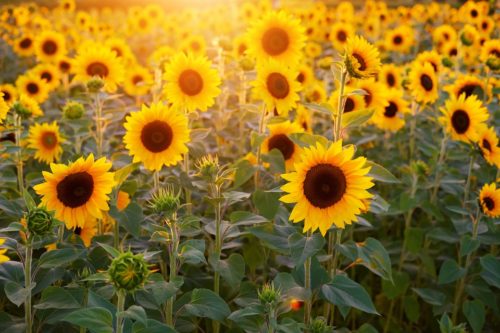 Seeds are plant embryos, or mini-plants. Examples students might recognize include corn, peas, beans, pecans, rice, oats, peanuts, sesame, cashews, almonds, millet, sorghum, chia, quinoa, and lentils.
Seeds are plant embryos, or mini-plants. Examples students might recognize include corn, peas, beans, pecans, rice, oats, peanuts, sesame, cashews, almonds, millet, sorghum, chia, quinoa, and lentils.
Seeds are also a great opportunity to discuss the differences between native, nonnative, and invasive plants,
Edible seeds include:
- Annual Sunflower: It’s likely that students in your classroom have snacked on sunflower seeds. Those seeds come from different varieties of annual sunflowers, and they grow best in climates with good sun. Indigenous groups use the seeds for texture in their flours, dyes in textiles, and as a snack. Learn more here.
- Amaranth: You can also eat the greens from this leafy plant, but consumption of the seeds as a grain alternative goes back over 500 years. Use amaranth as a replacement for quinoa in soups, stews, and chilis. It can also be ground up into a gluten-free flour for baked goods. Learn more here.
Check out the Have Seeds, Will Travel activity in the Explore Your Environment guide to teach students about seed dispersal.
Stems, Stalks, and Bulbs
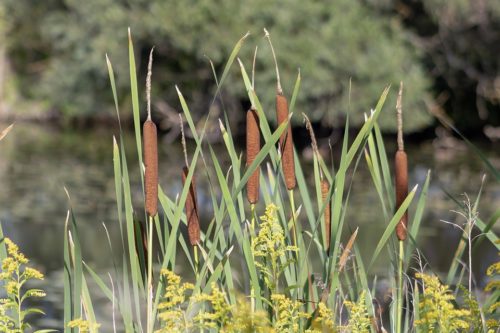 Stems, stalks, and bulbs make up the structure of a plant, carrying water and other nutrients from the roots to the rest of the plant and stabilizing the plant in the process.
Stems, stalks, and bulbs make up the structure of a plant, carrying water and other nutrients from the roots to the rest of the plant and stabilizing the plant in the process.
A bulb is actually a modified stem. It lives underground and allows plants to go dormant when they need to in between growing seasons. Examples of these plant parts include asparagus, celery, rhubarb, bamboo, onions, and garlic.
Edible stems, stalks, and bulbs in United States include:
- Cattail: These marsh plants are found in waters all over North America. Young cattail stems can be eaten raw or boiled. The stems worked well in home construction or as a good source, the pollen added flavor to cooking, and the flowerheads were woven into clothing. Learn more here.
- Fireweed: This wildflower thrives in areas at sea level and above. You can eat the leaves and stalks of this plant raw or cooked as an alternative to asparagus. Indigenous Peoples have boiled the stems as a food source and have braided stems for use as fishing nets. Learn more here.
- Bark: Edible bark refers to the inner bark of a tree. This is a true survivalist snack, as it requires quite a bit of prep to strip the tree. Fresh and roasted tree bark was an important part of the Indigenous Peoples’ diet, particularly in the Adirondacks. Fun fact: Adirondack comes from a Mohawk word that means “eaters of trees.” Learn more here.
Roots, Tubers, and Rhizomes
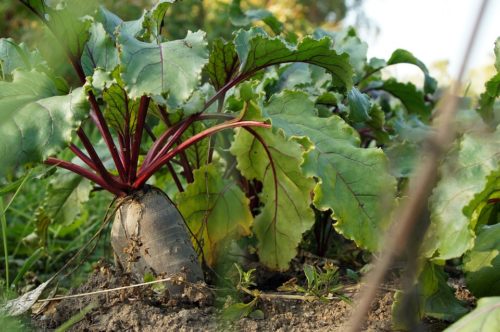 These plant parts are essential to the structure of plants. Roots anchor plants, allow plants to absorb water and minerals that come from the stem, and store reserves. Tubers and rhizomes also store nutrients for plants, particularly during dry or cold winter months, but they differ in how they grow and reproduce. Tubers grow in any direction and sprout new shoots from nodes, or eyes. Rhizomes grow horizontally and sprout new shoots from along their stem.
These plant parts are essential to the structure of plants. Roots anchor plants, allow plants to absorb water and minerals that come from the stem, and store reserves. Tubers and rhizomes also store nutrients for plants, particularly during dry or cold winter months, but they differ in how they grow and reproduce. Tubers grow in any direction and sprout new shoots from nodes, or eyes. Rhizomes grow horizontally and sprout new shoots from along their stem.
Familiar examples of roots are carrots, beets, radishes, and jicama. Tubers include potatoes, yams, and sweet potatoes. Tumeric and ginger are rhizomes.
Edible roots, tubers, and rhizomes in the United States include:
- Wood Sorrel: We’ve already talked about the edible leaves of the redwood sorrel. The common wood sorrel found all over the country is also edible, from its leaves to its tubers. You can eat the sour tubers as a foraging snack. Indigenous Peoples have used them for medicinal purposes. Learn more here.
- American Groundnut: These starchy tubers are also known as potato beans, and they’re native to much of the country. Eat them boiled, roasted, or fried, just as you would with potatoes. Just reduce your cooking time, as they cook and crisp up faster than the usual taters. Learn more here.
- Large Indian Breadroot/Prairie Turnip: This root vegetable is native to prairies and wooded areas all over North America, and was a food staple for the Indigenous Peoples of the Great Plains. Use it just as you would any turnip. It can be boiled, baked, fried, or roasted. Learn more here.
Sap
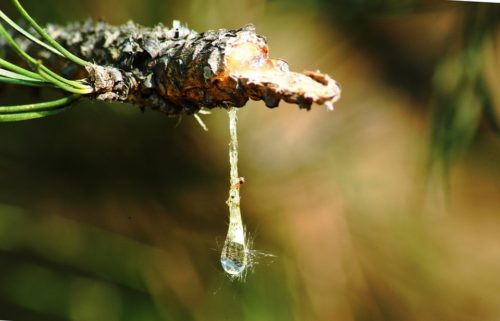 Sap is the sticky liquid that helps trees transport everything they need throughout their branches. That includes water and other energy sources. Students in your classroom may recognize the most popular edible sap: maple syrup. The syrup comes from the sap of maple trees. Indigenous communities have been using it as a sweetener long before we realized it pairs well with pancakes.
Sap is the sticky liquid that helps trees transport everything they need throughout their branches. That includes water and other energy sources. Students in your classroom may recognize the most popular edible sap: maple syrup. The syrup comes from the sap of maple trees. Indigenous communities have been using it as a sweetener long before we realized it pairs well with pancakes.
There are other types of syrup that can be made from sap, like boxelders, black walnut trees, and a variety of birch trees. Learn about even more sap-producing trees here.
Teaching About Edible Plants
You can incorporate edible plants into your classroom in a wide variety of ways. A fun way to get started is to grow an edible garden where you can enjoy the fruits (and vegetables) of your labor!
Check out the Here We Grow Again activity in the Explore Your Environment guide. Children of any age would love it if you turned your classroom into a kitchen to lead them through a cooking demo of edible plants.
With younger students, try:
- Visual labeling activities of edible plant parts,
- Sorting activities of plant parts we can/cannot eat,
- Sensory lessons to feel the differences of each plant component, and
- Kinesthetic lessons where students mimic each plant part with their bodies.
With older students, try:
- Diving into the history of plants as food,
- Comparing and contrasting plants as food from different cultural perspectives,
- Researching Indigenous movements to reestablish or strengthen these traditional food sources,
- Connecting the biological functions of edible plant parts to science lessons, and
- Teaching about why geography matters to the sustainability of these plants.


